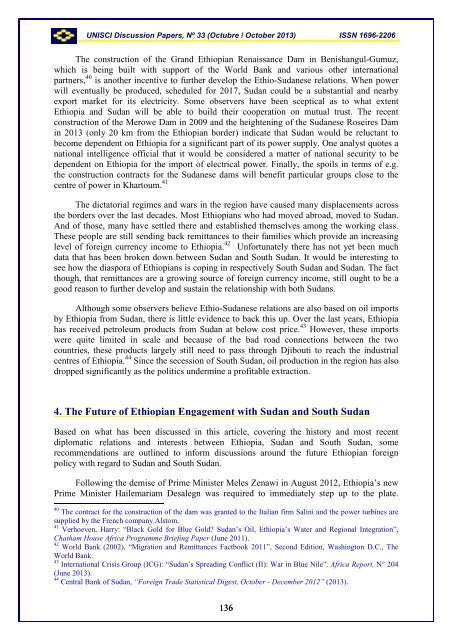UNISCI - Universidad Complutense de Madrid
UNISCI - Universidad Complutense de Madrid
UNISCI - Universidad Complutense de Madrid
You also want an ePaper? Increase the reach of your titles
YUMPU automatically turns print PDFs into web optimized ePapers that Google loves.
<strong>UNISCI</strong> Discussion Papers, Nº 33 (Octubre / October 2013) ISSN 1696-2206The construction of the Grand Ethiopian Renaissance Dam in Benishangul-Gumuz,which is being built with support of the World Bank and various other internationalpartners, 40 is another incentive to further <strong>de</strong>velop the Ethio-Sudanese relations. When powerwill eventually be produced, scheduled for 2017, Sudan could be a substantial and nearbyexport market for its electricity. Some observers have been sceptical as to what extentEthiopia and Sudan will be able to build their cooperation on mutual trust. The recentconstruction of the Merowe Dam in 2009 and the heightening of the Sudanese Roseires Damin 2013 (only 20 km from the Ethiopian bor<strong>de</strong>r) indicate that Sudan would be reluctant tobecome <strong>de</strong>pen<strong>de</strong>nt on Ethiopia for a significant part of its power supply. One analyst quotes anational intelligence official that it would be consi<strong>de</strong>red a matter of national security to be<strong>de</strong>pen<strong>de</strong>nt on Ethiopia for the import of electrical power. Finally, the spoils in terms of e.g.the construction contracts for the Sudanese dams will benefit particular groups close to thecentre of power in Khartoum. 41The dictatorial regimes and wars in the region have caused many displacements acrossthe bor<strong>de</strong>rs over the last <strong>de</strong>ca<strong>de</strong>s. Most Ethiopians who had moved abroad, moved to Sudan.And of those, many have settled there and established themselves among the working class.These people are still sending back remittances to their families which provi<strong>de</strong> an increasinglevel of foreign currency income to Ethiopia. 42 Unfortunately there has not yet been muchdata that has been broken down between Sudan and South Sudan. It would be interesting tosee how the diaspora of Ethiopians is coping in respectively South Sudan and Sudan. The factthough, that remittances are a growing source of foreign currency income, still ought to be agood reason to further <strong>de</strong>velop and sustain the relationship with both Sudans.Although some observers believe Ethio-Sudanese relations are also based on oil importsby Ethiopia from Sudan, there is little evi<strong>de</strong>nce to back this up. Over the last years, Ethiopiahas received petroleum products from Sudan at below cost price. 43 However, these importswere quite limited in scale and because of the bad road connections between the twocountries, these products largely still need to pass through Djibouti to reach the industrialcentres of Ethiopia. 44 Since the secession of South Sudan, oil production in the region has alsodropped significantly as the politics un<strong>de</strong>rmine a profitable extraction.4. The Future of Ethiopian Engagement with Sudan and South SudanBased on what has been discussed in this article, covering the history and most recentdiplomatic relations and interests between Ethiopia, Sudan and South Sudan, somerecommendations are outlined to inform discussions around the future Ethiopian foreignpolicy with regard to Sudan and South Sudan.Following the <strong>de</strong>mise of Prime Minister Meles Zenawi in August 2012, Ethiopia’s newPrime Minister Hailemariam Desalegn was required to immediately step up to the plate.40 The contract for the construction of the dam was granted to the Italian firm Salini and the power turbines aresupplied by the French company Alstom.41 Verhoeven, Harry: “Black Gold for Blue Gold? Sudan’s Oil, Ethiopia’s Water and Regional Integration”,Chatham House Africa Programme Briefing Paper (June 2011).42 World Bank (2002), “Migration and Remittances Factbook 2011”, Second Edition, Washington D.C., TheWorld Bank.43 International Crisis Group (ICG): “Sudan’s Spreading Conflict (II): War in Blue Nile”, Africa Report, N° 204(June 2013).44 Central Bank of Sudan, “Foreign Tra<strong>de</strong> Statistical Digest, October - December 2012” (2013).136
















